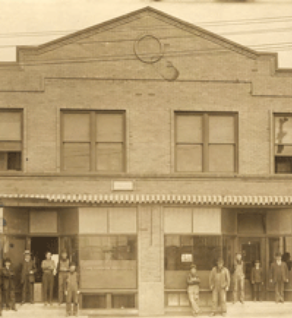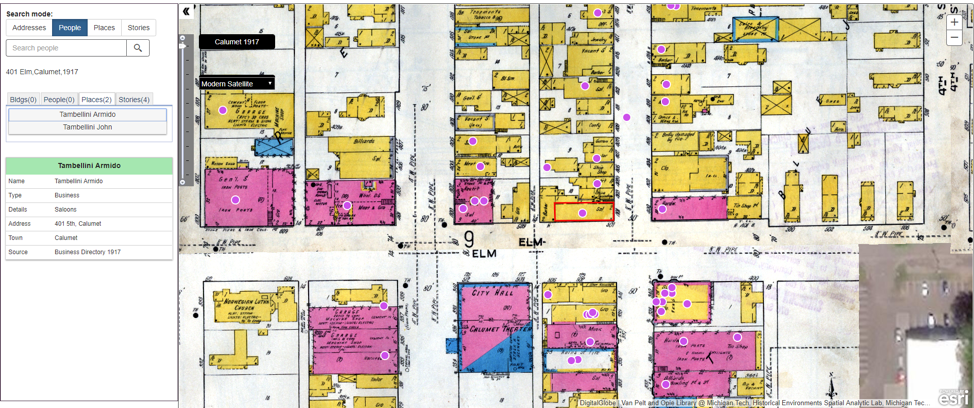|
See our new StoryMap about the Calumet Colosseum at:
http://calumetcolosseum.keweenawhistory.com The former mining town of Calumet is a prominent place within the Keweenaw Time Traveler. Recently Calumet’s indoor hockey rink, the Calumet Colosseum, was voted Kraft Hockeyville USA 2019. This annual competition recognizes important community hockey rinks across the USA and the finalists are nominated largely based on the strength of their “community story.” Each year’s winner receives $100,000 in rink upgrades and plays host to an NHL preseason match. This year, the Detroit Red Wings will play the St Louis Blues on September 26th – in the Calumet Colosseum! So what makes the Calumet Colosseum’s story special enough to win a national competition? For starters, it is the oldest indoor hockey rink in the United States that is still in use, with the first puck having dropped way back in 1913! But that’s just the beginning. To help share the Colosseum’s story, the Keweenaw Time Traveler Team has built an interactive StoryMap to take a deeper dive into the Colosseum’s long history. The KeTT team has pored over the collection of historical resources in the Keweenaw Time Traveler – historical maps, city directories, and other records – to shed light on the early years of the Colosseum, and the town of Calumet’s long association with hockey. Despite being located in Michigan’s Upper Peninsula, far from today’s NHL teams, the Colosseum is no stranger to professional hockey. In fact, in 1905 the very first professional hockey league season ever played in the USA was won by a team from Calumet! But the most important part of the Colosseum’s story is the role it played, and continues to play, in the community. Thousands of professional, amateur, high school, and collegiate players have passed through its doors over the last century, and many thousands more spectators have come to see them play. We couldn’t possibly capture all of those stories in this StoryMap – but YOU can help us share the Colosseum’s story by sharing your own memories of this historic rink in the Keweenaw Time Traveler. Just go to the Keweenaw Time Traveler’s Explore app and click the “Share a Story” button to get started. Let’s show the world why there is no place that deserves the title “Hockeyville USA!” better than Calumet and the Colosseum!
0 Comments
(Today's blog post goes behind-the-scenes and features one of our Time Traveler Team members describing one of the many projects we've undertaken to expand the Keweenaw Time Traveler!) Hi, my name is Charles and I’m one of the new research associates working on the Keweenaw Time Traveller. I’m a fourth-year anthropology student at Michigan Tech and this summer I’ve been mainly working on adding story points to the Keweenaw Time Traveler from historic sources. These help to give additional context to areas and buildings. So far, most of these stories have been from the National Park Service (NPS) which has done a terrific job of recording the past. For example, the article “Windows Into the Past” from the NPS website listed a number of locations in Calumet, formerly the town of Red Jacket, their addresses, and a small blurb about the history of the site. These are perfect for adding to the Time Traveler as the information is well researched and can somewhat easily be linked to specific places. Now, for those who have used the Time Traveler, adding this information might seem like an easy task, given that it’s just finding an address and adding a story point. However, there’s a lot more to it than one may think. It’s a lot like detective work, using clues to find the exact location of a story. One of the biggest issues is actually finding the right address. Compare these two pictures from the 200 block on Main Street Calumet, one from 1900 and the other from 1917. As you can see the numbering systems are entirely different! This makes putting down a story point difficult, though not impossible. This is where the detective work comes in. For one, reading the location’s story gives some good indicators, as it can show what the building was used for and when it was built. The historical maps help in this regard, as they often tell what a building was used for and you can change the year in the Time Traveler to get close to the date when it was built. Additionally, Google Maps street view is a big help. Each location listed in the NPS article has a picture of the building attached, which can be compared to buildings in street view. While not all of the architectural features remain, such as the storefront above, larger features like columns and crenellations remain and can confirm a building's location and identity. This helped locate a number of buildings, although if major renovations happened or if the place got torn down it was a lot less help. Finally, sometimes the description of locations would include who lived or owned the building. Using the Time Travellers ‘people’ search tool, it was easy to see who lived where and when, and then compare that with the story attached to the location. This cracked some of the tougher mysteries of location which didn’t have an address attached. Oftentimes, the owners of buildings would have their stores on the bottom floor while the families private residences would be on the upper ones. So by searching for a family name, you could find the buildings they owned rather easily.  Lake Superior Produce building, 1917 (NPS). Lake Superior Produce building, 1917 (NPS). Hopefully, going forward, regular contributors to the Time Traveller can use these same methods to add stories from other historical databases. It made it quite easy for me to add story points and learn about the historical context of the area. One of my favorite locations was the Lake Superior Produce building, which supplied Calumet with a good deal of its food in the early 1900s. The building and most of the surroundings are no longer there, and it’s interesting to see how much of the landscape of the town changed in 100 years. That’s all from me so far! I hope these techniques inspire other fellow time travelers to add some more stories about hard to find places! |
|




 RSS Feed
RSS Feed



